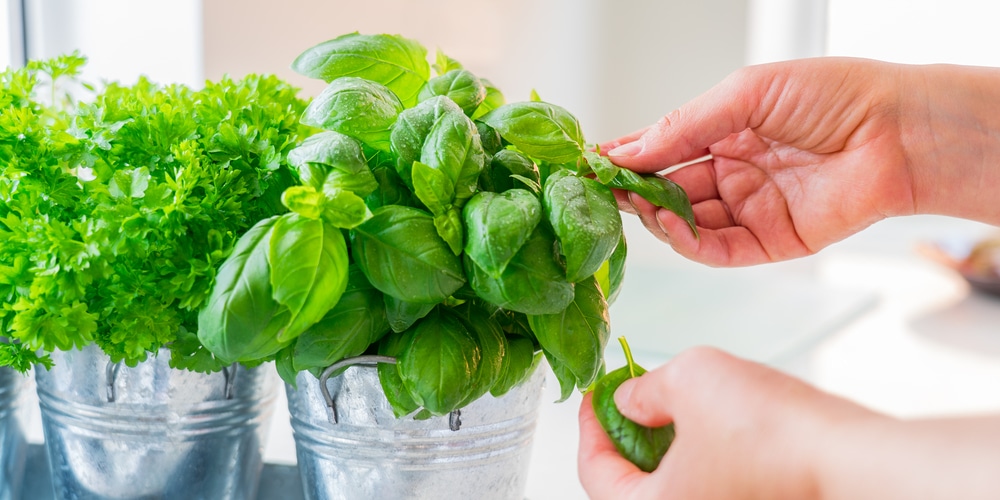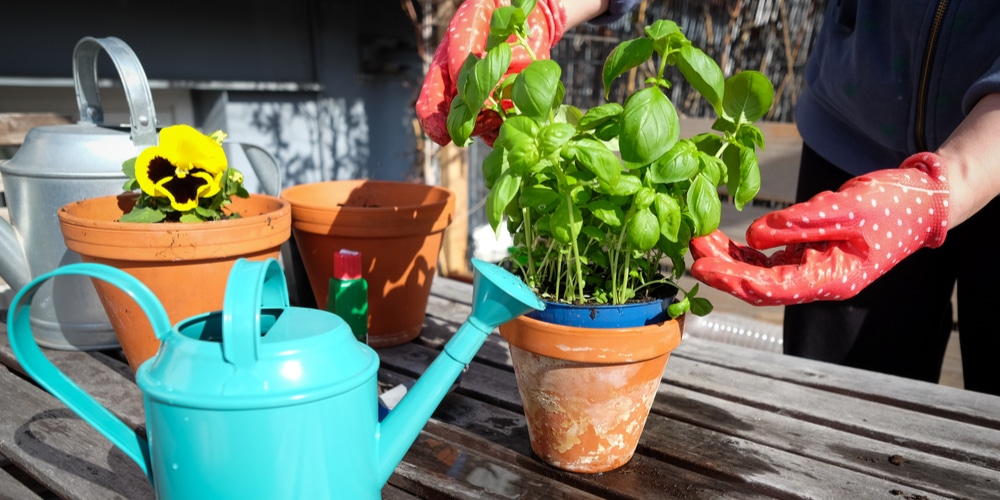With adequate care, basil is a prolific herb that will provide you with plenty of delicious leaves to add a delicate flavor to your dishes. You can add it to salads, use its leaves in soups, make pesto with it, or use it as a garnish on your pizzas and sandwiches. And you know what the best part is?
Make Sure Your Basil Plant is Healthy Before Harvesting It

The plant isn’t particularly challenging to grow, provided that you ensure you give it all it needs to thrive. Luckily, this member of the mint family isn’t fussy. It grows well indoors and outdoors but needs adequate watering, sunlight, and proper soil. Don’t forget that these plants love direct sun: if you can, place them in a sunny location.
Your reward will be a voluminous crop. Even beginners won’t struggle growing basil: this plant is a fast grower and will get from seed to harvest in as little as three to four weeks.
Harvesting your plants is a process that promotes growth and keeps your basil healthy as it ensures adequate airflow and discourages flowering. But can you harvest your plant too much? And what can you do about it? Don’t worry: we are here to help you!
Keep reading if you want to learn how to harvest basil without killing the plant. In this essential guide, we’ll go through everything you need to know about picking leaves from your basil plant without harming it (and ensuring it will keep growing).
How To Cut Basil Without Killing The Plant
As we mentioned, picking basil leaves is a crucial step to ensure your plant keeps thriving. However, to promote healthy growth, you should take some steps to avoid damaging your plant.
Usually, if you want to add a leaf or two of basil to your meal, you can pinch off what you need from the top of your plant without worrying about where you take it. But if you want to harvest more leaves (maybe to make a delicious homemade pesto), you must take a different approach.
For starters, it is best to harvest the stems starting from the top to the bottom under such circumstances. Don’t forget to pick leaves only when your plant is about six inches to eight inches tall. Plus, leave at least one pair of leaves at the bottom of the stem to allow it to grow denser after harvesting.
Avoid cutting off an entire stem as you might cause its death. Plus, don’t harvest more than half of the plant. Leaving some leaves on will give your basil more time to recover. You’ll see new growth in two to three weeks, provided that you give your plant proper care.
The best time to harvest your plants is in the morning, which will give you the juiciest leaves. But, the truth is that you can pick your basil whenever you need it. If you aim to encourage growth, you should take your leaves from stems with about six to eight leaves and prune the center shoot of the plant.
Avoid tearing or damaging your plant’s stem. Instead, gently pull away from the entire leaf from it. If you are afraid that you don’t have a gentle touch: cut the leaves with a pair of scissors (without harming the stem).
Also, you must avoid leaving flowers on your basil plant: remove them as soon as you see them. Leaving them on the plant might result in fewer leaves and can even affect the taste of your basil, making it bitter. Also, if you regularly remove flower buds, you’ll strengthen your basil’s life and secure more voluminous harvests.
If you live in a cold region, remember to harvest all of your basil before the first frost arrives: cold temperatures will damage your plant. If you can, consider moving your plant indoors to protect your basil from lower temperatures.
Pruning your Basil Plant
Pruning, besides harvesting, is another crucial step to encourage the growth of a healthy basil plant. It helps minimize attacks from pests and diseases and will make your plant denser. To do so, trim your plant from the top, removing stems.
Don’t forget that you should prune your basil when it is large and tall enough to avoid killing your plant. Cut stems above the leaf node to boost growth. The process isn’t challenging: check for unhealthy or dead branches and remove them.
Related Article: How to Grow Basil in Arizona

